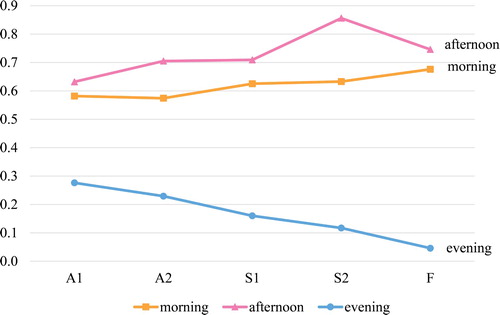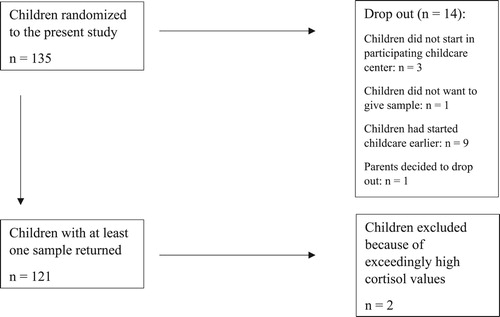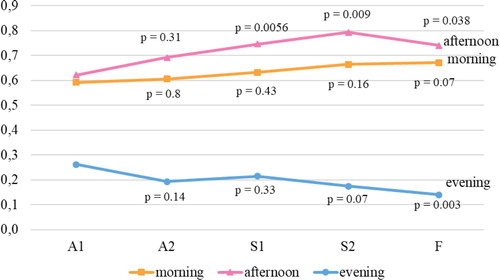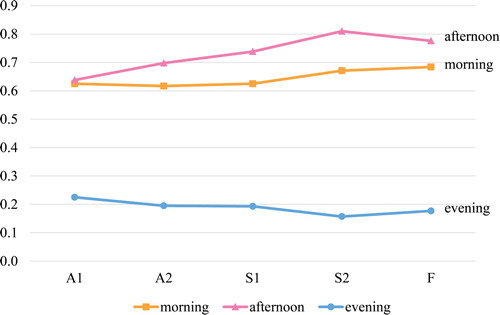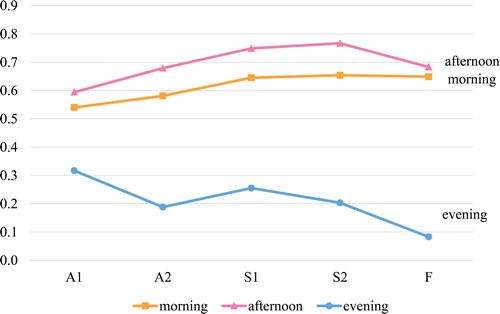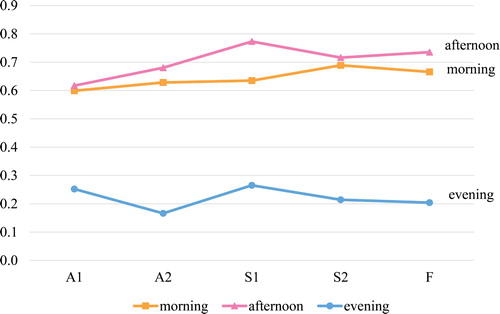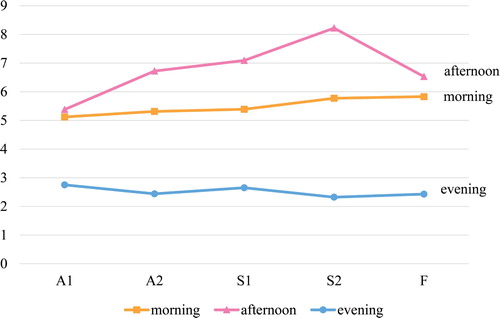ABSTRACT
In toddlers, the transition from home to childcare might elicit high levels of the stress hormone cortisol. Measuring cortisol may give an indicator for children’s experience and hence, may help improve this transition. We applied linear mixed model analyses to investigate the cortisol levels of 119 toddlers during their transition to childcare across time of day (morning, afternoon, and evening) and phase (accompanied by parents, separated from parents, and after four to six weeks in childcare). The influence of age, gender, number of siblings, and childcare group size was analyzed. Time of day and phase influenced cortisol levels significantly. On average, children had elevated cortisol levels in the afternoon throughout transition, with the peak coming in the separation phase. Cortisol levels declined significantly toward the evening. Children younger than 14 months showed higher evening levels and higher afternoon levels after 4–6 weeks in childcare. The findings suggest that the onset of childcare – particularly separation from parents – may be demanding for toddlers. Low evening levels indicate relief of tension at home. Higher levels of afternoon cortisol of under 14-months-old children at the follow-up measurement may indicate that younger children need more time to settle in at childcare.
Introduction
An increasing number of toddlers (one- and two-year-old children) in OECD countries are being enrolled in an out-of-home daycare arrangement (Organisation for Economic Co-operation and Development Citation2017). In Norway, more than 80% of one- and two-year-old children attend childcare (Statistics Norway Citation2020). Increased early childcare attendance has sparked debates about the effects of childcare on children’s development and attachment relationships (Belsky Citation2001). Research, though, cannot connect early childcare to systematically adverse outcomes (Lekhal Citation2012; NICHD - Early Child Care Research Network Citation2002). Yet issues of childcare concern a large percentage of young children today and entering childcare may be a demanding process for many toddlers. Transition practices have recently been discussed among parents, caregivers, and researchers in Norway, particularly parents’ important role during acclimatization (Drugli Citation2017; Humberset and Andersen Citation2018; Ramberg Citation2017).
The transition from home to childcare can be particularly demanding for toddlers. In childcare, toddlers meet new adults and peers in an unfamiliar environment. For the first time, many toddlers spend significant parts of the day without their parents, on whom they rely for emotional regulation (Ereky-Stevens et al. Citation2018). Observational studies have found that many children show signs of struggle during their first weeks in childcare (Datler et al. Citation2012; Datler, Datler, and Funder Citation2010). O'Connor (Citation2013) and Brooker (Citation2008) argue that good transitions are important for children’s short- and long-term wellbeing, as well as their development in childcare. At the same time, we do not know enough about how toddlers react to transitions. There is little quantitative research on this matter.
Measuring the levels of the stress hormone cortisol may give an indication of children’s experience in childcare, hence forming a method to research these transitions systematically (Vermeer and van Ijzendoorn Citation2006). Measuring cortisol levels can help in understanding a toddler’s perception of transition to childcare in greater detail and may enable us to better adjust practices to meet children’s needs. So far, few studies have looked at toddlers’ cortisol activity in childcare.
The important first transition
Going from home to childcare is the first major transition in many children’s lives. Toddlers may not be emotionally and cognitively mature enough to regulate their feelings during separation from their parents, and might therefore not be able to adjust to a new environment with little difficulty (Schore and Schore Citation2008).
Observational studies have detected signs of distress (Cryer et al. Citation2005; Datler et al. Citation2012) and the tendency for staff to overlook children’s silent struggles during transitions (Datler et al. Citation2012; Datler, Datler, and Funder Citation2010). However, toddlers have also been observed navigating transitions in an active manner and without signs of greater distress (Simonsson Citation2015). Qualitative findings have suggested that a gradual acclimatization, one with a high involvement of parents and a primary key person among the caregivers, eases a transition (Brooker Citation2008; Ebbeck and Yim Citation2009; Markström and Simonsson Citation2017; Undheim and Drugli Citation2012).
While transitions require adjustment and may evoke feelings of insecurity, they also hold great opportunity to acquire new competences and relationships if done well (Brooker Citation2008). According to Bronfenbrenner’s (Citation1979) ecological systems theory, the transition from a familiar micro-system (the family) to an unfamiliar one (the childcare center) can be facilitated by a parent entering the new system together with the child as a bridge-builder. A good connection between the micro-systems is of great importance for the child. If a parent is present in the new setting and has the opportunity to interact positively together with the child and the new caregiver, a row of benefits, such as greater security and new social relationships, can emerge. In Reggio Emilia childcare centers in Italy, caregivers actively work to establish relationships with children and parents during transition, ‘Inserimento’. Parents are recognized as a central basis for children, from which they can get to know caregivers and the childcare center. Children’s attention is gradually directed from parents toward the new caregivers. Ideally, caregivers, children and parents have met several times before childcare starts (Degotardi and Pearson Citation2014). The previously mentioned key person approach builds amongst other on attachment theory by Bowlby (Elfer, Goldschmied, and Selleck Citation2012). Young children seek to form close relationships. Such special relationships are important for children to regulate feelings and develop emotional competences (Schore and Schore Citation2008), which are an essential ingredient for healthy brain development (Center on the Developing Child Citation2012). Today, it is recognized that also professional caregivers can become important relational figures to a child. A key-person approach may help to establish close relationships to caregivers, giving children a safe haven in childcare and opportunity for meaningful interactions (Elfer, Goldschmied, and Selleck Citation2012).
Cortisol in childcare
Cortisol is the main product of the hypothalamic–pituitary–adrenal axis (HPA), one of the body’s major stress systems. Cortisol is also part of regular metabolism. Cortisol levels generally vary in a diurnal cycle, with the highest values in the morning and a steady decline throughout the day (Gunnar and Herrera Citation2013). This typical pattern is established in humans from an early age (Gunnar and Quevedo Citation2007) and has been observed by Watamura et al. (Citation2004) in children aged 12 months. Cortisol levels rise if one perceives a situation to be overly demanding and socially threatening (Gunnar and Quevedo Citation2007). Elevated levels of cortisol may be an indicator of social stress (Kirschbaum et al. Citation1990; Kirschbaum and Hellhammer Citation1994; Vermeer and van Ijzendoorn Citation2006), and hence, measuring cortisol may be a suitable method to evaluate children’s experiences in childcare.
A meta-analysis by Vermeer and van Ijzendoorn (Citation2006) suggested that toddlers tend to show higher levels of cortisol in childcare when compared with them being at home, and they do so more than other age groups. This finding has been supported in further studies (Bernard et al. Citation2015; Drugli et al. Citation2018; Groeneveld et al. Citation2010; Ouellet-Morin et al. Citation2010; Sumner, Bernard, and Dozier Citation2010; Vermeer et al. Citation2010). Indeed, the transition to childcare might elicit especially high cortisol levels (Ahnert et al. Citation2004; Bernard et al. Citation2015).
Extensive research documented the harmful effects of negative stress, such as neglect, maltreatment or other trauma, to brain development (Center on the Developing Child Citation2007, Citation2017). A prolonged elevation of cortisol could have negative effects, such as a weakened immune system (Watamura et al. Citation2010), inhibited cognitive development (Phillips, Fox, and Gunnar Citation2011) and greater sensitivity to stress in later life (Loman and Gunnar Citation2010). Cortisol elevations registered in childcare are not exceedingly high. At the same time, we do not know enough about this comparably milder form of stress and its effects on children’s development (Gunnar and Herrera Citation2013; Vermeer and van Ijzendoorn Citation2006). Some elevation of cortisol seems to be necessary to reach the next steps of development (Center on the Developing Child Citation2017). According to Suhonen et al. (Citation2018), learning might involve a balanced stress reaction, comprised by stress activation which alerts physical systems followed by stress regulation which enables the organism to give an appropriate answer to a stressor, thereby avoiding a flight, fight or freeze response. Slightly heightened cortisol levels over brief periods of time might therefore be a sign of a learning process. Similarly, the Center on the Developing Child (Citation2017) describes short and mild elevations of stress hormones in the context of supportive relationships as ‘positive stress’. Positive stress is argued to be important for children’s development and the establishment of a healthy stress response system.
Cortisol during the transition to childcare
To the best of our knowledge, only two studies have investigated toddlers’ cortisol levels under the transition to childcare. Ahnert et al. (Citation2004) measured morning cortisol during transition, upon arrival to childcare and 30 and 60 min later. In addition, they measured the same time points on days at home to assess the baseline of cortisol. On days when mothers were still present in the center, children showed just a slight cortisol elevation compared with at home. Yet this elevation was much higher for children with an insecure attachment style. Children exhibited the most elevated levels the first mornings separated from their mothers. At five months after entering childcare, levels were still higher compared with baseline but were significantly lower than during separation. Bernard et al. (Citation2015) measured the cortisol levels of infants, preschoolers, and elementary school children during the first 10 weeks in a new childcare setting. Cortisol was measured in the morning and the afternoon on two days at home, on the first day in the new childcare setting, and on one day in the second, fourth, sixth, eighth, and tenth weeks. They observed decreasing cortisol between morning and afternoon at home and raising cortisol when in childcare. Age had a significant effect, and preschoolers (aged 18–60 months) showed more cortisol elevation than infants or elementary school children. Cortisol elevations continued to increase for all children during the first 10 weeks in the novel childcare setting.
To the best of our knowledge, no one has yet examined evening home levels in toddlers during their transition to childcare. Sumner, Bernard, and Dozier (Citation2010), as well as Groeneveld et al. (Citation2010), registered a decrease of cortisol in the evening after childcare, but the participants of those studies were not in the process of transitioning to childcare.
Factors related to cortisol elevation
Because of the lack of research, it is not clear how demographic child and childcare features relate to toddlers’ cortisol levels during the transition to childcare and whether some groups are more influenced than others. Some studies that were conducted not during a transition but instead on regular childcare days, have found being male (Groeneveld et al. Citation2010; Ouellet-Morin et al. Citation2010) and of younger age (Ouellet-Morin et al. Citation2010) were associated with higher levels of cortisol. Legendre (Citation2003) linked structural elements of childcare, such as a large group size, an unexpected high number of caregivers, small play space, and a great age difference between children in the group, to elevated cortisol levels in toddlers. Yet the results are not conclusive, and there are also non-findings regarding toddler’s age (Groeneveld et al. Citation2010), gender (Drugli et al. Citation2018; Vermeer et al. Citation2010), as well as for elements of structural quality (Vermeer et al. Citation2010). To the best of our knowledge, nobody has yet explored whether toddlers with siblings cope differently with transitions to childcare. Danish researchers reported qualitative experiences of toddlers adjusting easier to childcare when their older siblings attended the same center (Jensen et al. Citation2015).
The present study
The present study is part of a large Norwegian study called Thrive by Three, which investigates childcare provision for the youngest children. In Norway, the majority of one-year-old (74.8%) and two-year-old (93.6%) children attend childcare. Most of them spend up to or more than 41 h in childcare each week (Statistics Norway Citation2020). When children start to attend childcare for the first time, they are accompanied by a parent on the first days in the center. A recent survey answered by approximately half of all Norwegian childcare centers reported that most children are attended by one parent for three days. Yet there was a variation in practice, and many centers offered a week or flexible parental attendance. Most centers scheduled meetings and center visitations in order to get to know parents before the onset of childcare (Drugli, Buøen, and Grip Citation2017). All Norwegian childcare centers have to adhere to the national Framework Plan for Kindergartens (Norwegian Directorate for Education and Training Citation2017). Yet, childcare practice has been observed to differ greatly (Lekhal and Nasjonalt Folkehelseinstitutt Citation2013). A recent, large scale quality measurement by Bjørnestad and Os (Citation2018) found Norwegian toddler childcare to be of middle-range quality.
Aims of the study
To adjust the practice of the transition to childcare better to toddlers needs, we need to identify the demanding stages of a transition and groups of children who might be challenged more than others. We will address the following research questions:
How do cortisol levels change during the day (morning, afternoon, and evening) and during different phases of transition (together with parents, separated from parents, and four to six weeks in childcare)?
How are gender, age at childcare entry, number of siblings, and group size related to cortisol levels during transition?
Based on the studies by Ahnert et al. (Citation2004) and Bernard et al. (Citation2015), we hypothesize that afternoon levels should be less elevated on the initial days in childcare accompanied by parents and then distinctly elevated in the afternoons compared with the mornings on the first days separated from parents and after four to six weeks in childcare. We hypothesize furthermore that cortisol levels will drop in the evening after children are picked up from childcare, as observed by Sumner, Bernard, and Dozier (Citation2010) and Groeneveld et al. (Citation2010). In addition, we want to study some basic child and childcare center variables and their influence on cortisol levels. We hypothesize that boys (Groeneveld et al. Citation2010; Ouellet-Morin et al. Citation2010), younger children (Ouellet-Morin et al. Citation2010), children without siblings (Jensen et al. Citation2015), and children in groups with a larger number of peers (Legendre Citation2003) might experience the transition as more challenging, therefore expressing higher levels of cortisol, particularly in the separation and follow-up phase.
Method
Participants
The present study was conducted on a subsample of the large Norwegian childcare study Thrive by Three. In 2017, leaders of childcare centers in seven municipalities in Eastern and Central Norway could enroll their center into the study. Thrive by Three applied a randomized-controlled design with an intervention group receiving a quality enhancement program and a control group. The sample of the present study consists of children from both groups. The quality intervention had not started when saliva sampling took place and, therefore, is unlikely to influence the present data.
Four to five of the Thrive by Three centers from each municipality were sampled. All children with valid consent from parents and who were starting childcare in autumn 2018 were eligible. Three centers were excluded from the present study because of a lack of eligible children. For details of recruitment, see and . For demographic information about the parents and children, see and .
Table 1. Parent demography, mother (n = 98, missing = 22) and father (n = 77, missing = 36).
Table 2. Child demography and group size.
Saliva sampling
In August 2018, we collected saliva samples from the children during their first weeks in childcare. Sampling occurred on six days in three phases: the second and third day accompanied by parents (acclimatization phase), the first and second day without parents (separation phase) and on two sequential days after four to six weeks in childcare (follow-up phase). Saliva sampling took place at 10 am and 3 pm in childcare and 6 pm at home.
Childcare centers were mailed saliva sampling kits with test tubes, swabs and written sampling guidance. Parents received a similar kit for their child from the childcare staff. Saliva samples were then collected at the according time points by employees in childcare and by parents at home. The Salimetrics’ SalivaBio Children’s Swab was used, which is intended for saliva sampling and validated for analysis of cortisol (Salimetrics Citation2019). Sampling was conducted in a playful manner to ease the procedure for the children. No stimulant was used. Childcare centers stored samples in household freezers until they were collected by the first author. The cortisol laboratory at the University of Trier, Germany, analyzed the saliva samples for their cortisol value by using a competitive solid phase time-resolved fluorescence immunoassay with fluorometric end point detection (DELFIA) (Dressendörfer et al. Citation1992). The samples were destroyed after analysis.
We received 63.5% (n = 1542) of all possible samples. Among these, the laboratory excluded 7.1% (n = 109) of the samples because they contained too little saliva for analysis. After analysis, 3.4% (n = 56) of the values were excluded because of an unlogic high cortisol value. Based on recommendations from the laboratory in Trier and the laboratory at St. Olav’s hospital in Trondheim, we decided to exclude values of more than 30 nmol/l because they likely reflected sickness or contamination. Over the course of this, we excluded two children from the analysis because of a constant pattern of exceedingly high values (Nicolson Citation2008). In total (1377 = 56.7%), the cortisol values from 119 children were available for analysis. Most children (n = 115) had one or more values missing, while four children had a complete set.
Questionnaire data
Parents answered an electronic questionnaire regarding their education, income, familial status, language background, and their child’s gender, age at childcare entry, and number of siblings. Childcare staff gave electronic information on the number of children in the childcare groups.
Statistics
We used a linear mixed model with the base 10 logarithm of cortisol concentration in nmol/l as the dependent variable and individual as random effect. Phase and day within phase were included as a five-category covariate: the acclimatization day 1 (A1), acclimatization day 2 (A2), separation day 1 (S1), separation day 2 (S2), and follow-up (days 1 and 2) (F). The two sampling days of the follow-up phase were coded as the same day, because there was no difference between them. Time of day was included as a three-category covariate: morning, afternoon, and evening, and we included the interaction between day and time of day. Next, we analyzed the associations among gender, age in months at childcare entry, number of siblings, and number of children in the group unit. The continuous variables age and group size were dichotomized at their median into approximately equally sized groups: Age: up to 13 months versus 14 months and older; group size: up to 11 children versus 12 children and more. Sibling number was dichotomized into either having siblings or not having siblings. These variables were entered one at a time in the linear mixed model, including their two- and three-way interactions with day and time of day. We did not impute the missing values. The linear mixed model includes every data point of cortisol in the analysis, regardless of the number of missing data points from the same individual (Krueger and Tian Citation2004). Normality of residuals was checked by visual inspection of QQ plots. Cortisol levels above 30 nmol/l were excluded from the analysis and regarded as missing values. We regard two-sided p-values <0.05 as statistically significant and report 95% confidence intervals (CI) where relevant. Analyses were carried out in SPSS26.
Ethics
Participation was voluntary for municipalities, childcare centers, caregivers, and parents. Both parents gave electronic consent for their child’s participation. Caregivers gave electronic consent as well. Withdrawal of consent was possible at all stages of the study.
We did not sample saliva from children who refused to participate in the sampling procedure.
Thrive by Three, and hence the present study, are approved by the Regional Committees for Medical and Health Research Ethics and the Norwegian Center for Research Data.
Results
First, we compared cortisol levels both between days during the different transition phases and times of day. and show the number of observations and estimated marginal means for each day and time of day.
Table 3. Estimated marginal means of log10-transformed cortisol (nmol/l).
Changes throughout the days
As seen in , there was a slight increase in morning cortisol level over the days of the transition. The p-values comparing each day with day A1 are shown in . Changes in morning cortisol were not statistically significant. For the afternoon, there was a higher increase in cortisol levels over the phases. As seen in , this was particularly the case for S2 compared with A1 (p=0.009). For the evening, there was a slight decrease in cortisol (). This decrease was statistically significant when comparing A1 and F.
Differences throughout time of day
On all days, the afternoon cortisol levels were higher than the morning cortisol levels. These differences were highest and statistically significant on day S1, S2 and F (see ). Untransformed average cortisol increased 42.5% from morning to afternoon on day S2. Respectively, it increased 31.5% on day S1 and 12% on day F. The evening levels were substantially lower than the morning and afternoon levels on all days. These differences were statistically highly significant. As can be seen in , the cortisol levels showed a greater standard deviation on the afternoon of S2 compared with other afternoons or the corresponding evenings.
Figure 5. Estimated marginal means of cortisol in nmol/l (log10-transformed) with p-values of change compared to morning.

Table 4. Descriptive statistics of untransformed cortisol (nmol/l).
Influence of age, gender, number of siblings and group size on cortisol
Second, we investigated how age at childcare entry, gender, group size, and number of siblings influenced cortisol activity. Gender and group size did not yield statistically relevant effects. Children with siblings showed higher morning cortisol levels than children without siblings, but the effects were not significant. The corresponding graphs are shown in the appendix (Figures ). Age produced a highly significant main effect. Also, the interaction between time of day and age was significant. and and show the estimated marginal means for the respective age groups.
Figure 6. Estimated marginal means of cortisol in nmol/l (log10-transformed) for children up to 13 months.
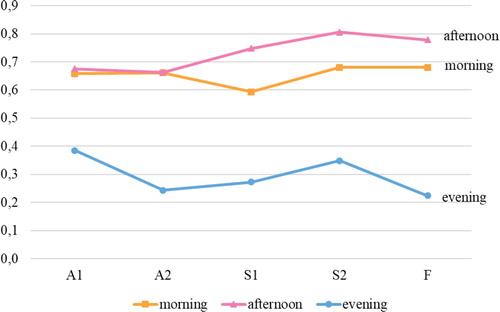
Figure 7. Estimated marginal means of cortisol in nmol/l (log10-transformed) for children 14 months and older.
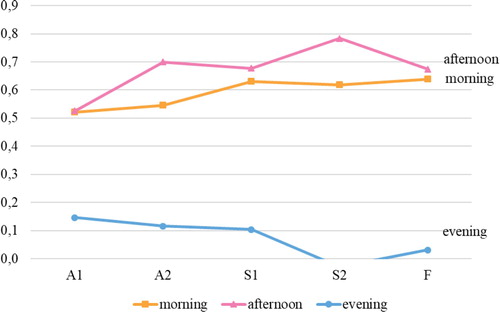
Table 5. Estimated marginal means of log10-transformed cortisol (nmol/l) by age.
illustrates the difference between the age groups by subtracting the estimated marginal mean of the older group from the estimated marginal mean of the younger group. Morning cortisol was higher for younger children on A1 and A2. Differences in morning cortisol were minor on other days. Afternoon cortisol was higher for younger children on A1 and F and slightly lower on A2. The difference was minor on the separation days. Younger children’s evening levels were well above the levels of the older group on all days of the transition, with an especially large difference on the evening of day S2.
Table 6. Differences of estimated marginal means by age (≤13–>13).
Discussion
In the present study, we investigated toddlers’ cortisol activity during their transition to childcare. We compared cortisol levels under acclimatization with parents, separation from parents and after four to six weeks in childcare in the morning and afternoon in childcare, as well as in the evening at home. We found significantly elevated cortisol levels on the afternoons of separation and follow-up days. However, cortisol levels had distinctly dropped on all evenings. Additionally, we tested the effect of the variables age, gender, number of siblings, and group size on cortisol activity. Age had a statistically significant effect on cortisol levels.
Primary findings: the cortisol curve
Afternoon cortisol levels were only slightly elevated on days together with parents in childcare. A nearly similar pattern was observed by Ahnert et al. (Citation2004). This suggests that the presence of a parent may have buffered the stress induced by the new setting, at least to some degree (Gunnar and Donzella Citation2002). Children might have a greater capacity to explore their new surroundings and interact with caregivers in the presence of a parent who can help regulate their emotions (Schore and Schore Citation2008) and bridge the gap between home and the new childcare context (Bronfenbrenner Citation1979). Therefore, extending the number of days together with parents if necessary may facilitate children’s familiarization with the center and caregivers (Brooker Citation2008). Ahnert et al. (Citation2004) did not find an effect of the number of days mothers spent in childcare on cortisol elevation during separation. Qualitative findings indicate that familiarity with the new context, especially with caregivers, preferably with a primary key person among them, helped children to settle in better (Brooker Citation2008; Ebbeck and Yim Citation2009).
Children showed distinctly elevated cortisol levels on the afternoons of separation. Indeed, the absence of parents seems to elicit distress, especially on the second afternoon. Ahnert et al. (Citation2004) also reported a clear stress response to separation from mothers. Toddlers might have diminished capacity to handle distress on the second afternoon alone, or they might have realized that parents are not coming back soon (Ahnert et al. Citation2004; Ahnert and Lamb Citation2003). A greater variation in the afternoon cortisol levels of the second day alone than on the other days in childcare might be an indication that some children experience more stress during their separation phase. The absence of parents might challenge children because of a diminished support to regulate feelings (Schore and Schore Citation2008). Having known children only for a few days, caregivers might not be able yet to soothe them well (Elfer, Goldschmied, and Selleck Citation2012). In addition, some children might experience little control over when and if parents are coming back, because of earlier experience (O'Connor Citation2013) or because they have not developed object permanence yet, meaning they do not know that parents exist when they are not there (Shaffer and Kipp Citation2014). Because the initial days of separation seem to be the most demanding part of transition for children, reduced hours might help to keep stress activation in balance (Vermeer and Groeneveld Citation2017). During our data collection, it was a frequent, verbally given feedback from the childcare centers that the children spent very short days together with their parents in childcare, whereas the separation days were comparably longer. By then, most parents had started working full time again after parental leave.
Afternoon cortisol levels were still somewhat elevated after four to six weeks in childcare. Children might have still been in the process of adapting to childcare. These elevated levels might also indicate that children experience childcare as challenging. This corresponds to the findings of the studies by both Bernard et al. (Citation2015) and Ahnert et al. (Citation2004), who reported elevated cortisol at a follow-up measurement after 10 weeks and five months. To help children to keep their stress activation balanced, it might be beneficial that parents continue with short days after the initial transition (Vermeer and Groeneveld Citation2017) and stay present with children for more days if necessary and possible (Brooker Citation2008). Toddlers who spend long hours in childcare have been found to show more cortisol elevation (Drugli et al. Citation2018). Although some parents benefit from flexible working hours in Norway, others need to adhere to a commute or to fixed schedules, hence depending on full-time childcare soon after the transition. Flexible parent leaves during the first weeks after starting childcare could help parents adjust the transitions to their child’s needs. Norway already has generous parent provisions, yet society still might profit from better transitions because this could potentially lead to less strain on children and thereby fewer days parents would have to stay home with sick children (Watamura et al. Citation2010). Process quality is likely an important factor when it comes to regulating stress in toddlers’ everyday childcare experience. Studies including older children have observed a connection between relational quality and cortisol levels in childcare (Badanes, Dmitrieva, and Watamura Citation2012; Sajaniemi et al. Citation2011). For toddlers, some studies have found a relation between elements of process quality and HPA activity (Groeneveld et al. Citation2010; Vermeer et al. Citation2010), while others did not (Drugli et al. Citation2018). The matter needs to be researched further (Vermeer and van Ijzendoorn Citation2006).
Evening cortisol levels were markedly lower than afternoon levels on all days. It seems that children experienced relief when they were at home after childcare. To the best of our knowledge, our study is the first to investigate cortisol levels in the evening after childcare during transition, thereby providing new knowledge. The findings correspond to the results of Groeneveld et al. (Citation2010) and Sumner, Bernard, and Dozier (Citation2010), who also registered a drop in evening cortisol. Those studies were conducted on regular childcare days, though, not during a transition.
Secondary findings: age
Children showed different patterns of cortisol activity according to age. These findings must be interpreted with caution, as children’s stress regulation may still be under development. A study by Watamura et al. (Citation2004) indicates that maturation of the HPA axis continues through the first three years of life. Cortisol levels of approximately 3-year-old children were overall lower than those of 1- and 2-year-old children. Blair et al. (Citation2011) suggest as well that baseline cortisol levels gradually sink throughout toddlerhood. Out of practical reasons we were not able to assess children’s cortisol baseline at home before starting childcare. This might have enhanced our understanding of the effect of age on cortisol.
We compared two age groups: up to 13 months and from 14 months up. Older children showed slightly higher afternoon cortisol levels on the third day after starting childcare while parents were still present in childcare. Parents might have left older children sooner alone, or they might not have kept as close to them as the parents of younger children had. There is reason to believe that separation occurs already on the third day of childcare in the Norwegian context (Drugli, Buøen, and Grip Citation2017). Older toddlers might have also been urged into more peer play by parents and caregivers. Contact with peers is suspected to cause an increase in cortisol (Gunnar and Quevedo Citation2007).
Younger children have been found to have a higher baseline of cortisol by Blair et al. (Citation2011), yet when comparing afternoon levels throughout the phases, we suspect that there might be an activation of younger children in the follow-up phase. While the afternoon level of older children decreased markedly between the separation and follow-up phase, younger children were equally activated on the second afternoon of separation and the follow-up afternoons. Children younger than 14 months may need more time to adjust to childcare. They might be emotionally less mature and might have a lower capacity to regulate the difficult feelings accompanying the transition (Schore and Schore Citation2008). Furthermore, younger children might have less social competence and, therefore, might experience peer contact and play as more demanding (Denham et al. Citation2003). Caregivers have to facilitate interaction between peers (Brooker Citation2008) and be attentive toward new children also after the initial transition to notice the, at times, subtle signs of discomfort and struggle (Datler et al. Citation2012). Adjustment to childcare is an extended process that might vary in length for different children (Brooker Citation2008; Datler et al. Citation2012). This is also highlighted by the concept of Inserimento in Reggio Emilia childcare (Degotardi and Pearson Citation2014). It might be beneficial that childcare centers focus on familiarizing children with routines (Brooker Citation2008) and reduce stimuli and activities in the afternoon, as children have been observed to be tired then (Undheim and Drugli Citation2012). Indeed, afternoon levels did not differ much by age during separation, suggesting that the absence of parents is relatively challenging, regardless of age.
Toddlers showed different evening levels according to age. Children younger than 14 months had higher evening cortisol levels than older children on all days. Younger children might have a flatter decline of cortisol due to maturation of the HPA axis (Blair et al. Citation2011; Watamura et al. Citation2004). It is also possible that younger children did not unwind as much and were more tense than older children at home after childcare. Yet also for younger children, cortisol levels dropped from afternoon to evening. Although there was no indication of an extended stress response, the matter should be researched more thoroughly. A prolonged activation of HPA has been linked to unfavorable outcomes, such as an inhibited immune system (Watamura et al. Citation2010), greater risk for a future vulnerability for stress (Loman and Gunnar Citation2010), and an inhibition of cognitive development (Phillips, Fox, and Gunnar Citation2011).
It is also possible that some younger children have a nap after childcare, resulting in an elevation of cortisol, which is called a cortisol awakening response (CAR) (Tervahartiala et al. Citation2019). However, evening napping has been observed to not produce much cortisol (Tribble et al. Citation2015). To alleviate tension, children might benefit from calm evenings with focused care from parents (Ahnert and Lamb Citation2003). The distinct decline of evening cortisol indicates that most parents soothed children after coming home. Ahnert, Rickert, and Lamb (Citation2000) reported that mothers gave more attention in the evening to toddlers attending childcare compared with mothers whose children did not attend childcare. This has been observed to be a powerful regulator of the HPA axis (Gunnar and Donzella Citation2002).
Strengths and limitations
The present study has some noteworthy strengths. We enrolled a larger number of participants than other cortisol studies on toddlers during transition to childcare (Ahnert et al. Citation2004; Bernard et al. Citation2015). Two days of measurement in three phases gave a good overview over the developments during the different stages of transition to childcare. Cortisol was measured in a full-day circle under transition for the first time.
The findings of the present study also need to be understood in the light of certain limitations. We have not assessed cortisol levels at home before starting childcare. Therefore, acclimatization days were applied as a baseline. Previous research gives strong indications that home cortisol is declining and that afternoon levels are lower compared with cortisol in childcare (Ahnert et al. Citation2004; Bernard et al. Citation2015; Drugli et al. Citation2018; Vermeer and van Ijzendoorn Citation2006). We assume this to be the case for our participants. A further study should assess this baseline level and investigate it for age differences.
There is a high percentage of missing cortisol data on certain time points, especially on afternoons together with parents in childcare. The linear mixed model analysis can process missing data better than other methods of analysis (Krueger and Tian Citation2004).
We have not controlled for napping, so a cortisol awakening response might be partly responsible for afternoon elevations (Tervahartiala et al. Citation2019; Tribble et al. Citation2015). Yet because napping should approximately have the same effect each afternoon, we might be able to neglect the difference. Furthermore, we have not controlled for the waking-up time in the morning and children’s morning cortisol might still be elevated by the morning CAR (Bäumler et al. Citation2013).
Cortisol levels are not assessed beyond four to six weeks after starting in childcare. Participants with a non-Norwegian language background are underrepresented in our sample (Statistics Norway Citation2019c). Parental education is well above the Norwegian average (Statistics Norway Citation2019a), and their income is slightly above regional average for families with young children (Statistics Norway Citation2019b). Children from a background with higher familial risk might show different cortisol patterns in the context of childcare (Berry et al. Citation2014).
Implications and future research
The findings of the present study hold implications for parents, caregivers, and policymakers. More time together with parents in childcare and shorter days during the separation phase could facilitate children’s transition. Parents should provide soothing and attention for their children in the evening after a day in childcare. Caregivers need to be attentive during children’s first months in childcare and focus especially on silent cues of discomfort. It is advisable that childcare centers provide calm afternoons and prioritize children’s familiarization with the caregivers, surroundings, and routines. Caregivers should also facilitate peer play. Flexible leave possibilities for parents during the children’s first weeks in childcare could help to adjust the transition practice to the needs of individual children.
There is little systematic research on toddlers’ transitions into childcare. Future studies should try to identify children who are more exposed to cortisol elevation during this transition than others. A further study should incorporate a larger sample of children to find the factors linked to greater elevations of cortisol during the transition to childcare.
Process quality in childcare (Vermeer and van Ijzendoorn Citation2006), as well as, children’s temperament (Dettling et al. Citation2000) and attachment style (Ahnert et al. Citation2004) might have an influence and need to be explored further. Also, the influence of transition practices on cortisol elevations, such as the number of days parents spend in childcare, primary contact approach, and cooperation between childcare and home should be investigated. Further studies should also explore the effect of age at childcare entry on cortisol levels a couple of months after transition.
Acknowledgements
The authors thank all children, parents and caregivers for participating in this study.
Disclosure statement
No potential conflict of interest was reported by the author(s).
Additional information
Funding
References
- Ahnert, L., M. R. Gunnar, M. E. Lamb, and M. Barthel. 2004. “Transition to Child Care: Associations With Infant-Mother Attachment, Infant Negative Emotion, and Cortisol Elevations.” Child Development 75 (3): 639–650. doi:10.1111/j.1467-8624.2004.00698.x.
- Ahnert, L., and M. E. Lamb. 2003. “Shared Care: Establishing a Balance Between Home and Child Care Settings.” Child Development 74 (4): 1044–1049. doi:10.1111/1467-8624.00587.
- Ahnert, L., H. Rickert, and M. E. Lamb. 2000. “Shared Caregiving: Comparisons Between Home and Child-care Settings.” Developmental Psychology 36 (3): 339–351. doi:10.1037/0012-1649.36.3.339.
- Badanes, L. S., J. Dmitrieva, and S. E. Watamura. 2012. “Understanding Cortisol Reactivity Across the Day at Child Care: The Potential Buffering Role of Secure Attachments to Caregivers.” Early Childhood Research Quarterly 27 (1): 156–165. doi:10.1016/j.ecresq.2011.05.005.
- Bäumler, D., C. Kirschbaum, M. Kliegel, N. Alexander, and T. Stalder. 2013. “The Cortisol Awakening Response in Toddlers and Young Children.” Psychoneuroendocrinology 38 (11): 2485–2492. doi:10.1016/j.psyneuen.2013.05.008.
- Belsky, J. 2001. “Emanuel Miller Lecture Developmental Risks (Still) Associated with Early Child Care.” Journal of Child Psychology and Psychiatry 42 (7): 845–859. doi:10.1111/1469-7610.00782.
- Bernard, K., E. Peloso, J.P. Laurenceau, Z. Zhang, and M. Dozier. 2015. “Examining Change in Cortisol Patterns During the 10-week Transition to a New Child-care Setting.” Child Development 86 (2): 456–471. doi:10.1111/cdev.12304.
- Berry, D., C. Blair, A. Ursache, M. Willoughby, P. Garrett-Peters, L. Vernon-Feagans, M. Bratsch-Hines, W. R. Mills-Koonce, and D. A. Granger. 2014. “Child Care and Cortisol Across Early Childhood: Context Matters.” Developmental Psychology 50 (2): 514–525. doi:10.1037/a0033379.
- Bjørnestad, E., and E. Os. 2018. “Quality in Norwegian Childcare for Toddlers Using ITERS-R.” European Early Childhood Education Research Journal 26 (1): 111–127. doi:10.1080/1350293X.2018.1412051.
- Blair, C., C. C. Raver, D. Granger, R. Mills-Koonce, and L. Hibel. 2011. “Allostasis and Allostatic Load in the Context of Poverty in Early Childhood.” Development and Psychopathology 23 (3): 845–857. doi:10.1017/s0954579411000344.
- Bronfenbrenner, U. 1979. The Ecology of Human Development. London: Harvard University Press.
- Brooker, L. 2008. Supporting Transitions in the Early Years: Supporting Early Learning. Maidenhead: McGraw-Hill Education.
- Center on the Developing Child. 2007. “The Impact of Early Adversity on Child Development (InBrief).” Accessed August 10, 2020. https://developingchild.harvard.edu/wp-content/uploads/2015/05/inbrief-adversity-1.pdf
- Center on the Developing Child. 2012. “Establishing a Level Foundation for Life: Mental Health Begins in Early Childhood: Working Paper No. 6.” Accessed August 10, 2020. https://developingchild.harvard.edu/wp-content/uploads/2008/05/Establishing-a-Level-Foundation-for-Life-Mental-Health-Begins-in-Early-Childhood.pdf.
- Center on the Developing Child. 2017. “Toxic Stress.” Accessed June 7, 2018. https://developingchild.harvard.edu/science/key-concepts/toxic-stress/.
- Cryer, D., L. Wagner-Moore, M. Burchinal, N. Yazejian, S. Hurwitz, and M. Wolery. 2005. “Effects of Transitions to New Child Care Classes on Infant/Toddler Distress and Behavior.” Early Childhood Research Quarterly 20 (1): 37–56. doi:10.1016/j.ecresq.2005.01.005.
- Datler, W., M. Datler, and A. Funder. 2010. “Struggling Against a Feeling of Becoming Lost: A Young Boy’s Painful Transition to Day Care.” Infant Observation 13 (1): 65–87. doi:10.1080/13698031003606659.
- Datler, W., K. Ereky-Stevens, N. Hover-Reisner, and L. E. Malmberg. 2012. “Toddlers’ Transition to Out-of-Home Day Care: Settling Into a New Care Environment.” Infant Behavior and Development 35 (3): 439–451. doi:10.1016/j.infbeh.2012.02.007.
- Degotardi, S., and E. Pearson. 2014. Relationship Worlds of Infants and Toddlers: Multiple Perspectives from Early Years Theory and Practice. Berkshire: Open Education Press. McGraw-Hill Education.
- Denham, S. A., K. A. Blair, E. DeMulder, J. Levitas, K. Sawyer, S. Auerbach-Major, and P. Queenan. 2003. “Preschool Emotional Competence: Pathway to Social Competence?” Child Development 74 (1): 238–256. doi:10.1111/1467-8624.00533.
- Dettling, A. C., S. W. Parker, S. Lane, A. Sebanc, and M. R. Gunnar. 2000. “Quality of Care and Temperament Determine Changes in Cortisol Concentrations Over the Day for Young Children in Childcare.” Psychoneuroendocrinology 25 (8): 819–836. doi:10.1016/S0306-4530(00)00028-7.
- Dressendörfer, R. A., C. Kirschbaum, W. Rohde, F. Stahl, and C. J. Strasburger. 1992. “Synthesis of a Cortisol-Biotin Conjugate and Evaluation as a Tracer in an Immunoassay for Salivary Cortisol Measurement.” The Journal of Steroid Biochemistry and Molecular Biology 43 (7): 683–692. doi:10.1016/0960-0760(92)90294-S.
- Drugli, M. B. 2017. “Foreldre bør være vaktbikkje når ettåringen skal begynne i barnehagen.” Adresseavisen, August 7. Accessed April 20, 2020. https://www.midtnorskdebatt.no/meninger/2017/08/07/Foreldre-b%C3%B8r-v%C3%A6re-vaktbikkje-n%C3%A5r-ett%C3%A5ringen-skal-begynne-i-barnehagen-15111094.ece.
- Drugli, M. B., E. S. Buøen, and M. S. Grip. 2017. “Rutiner for tilvenning i norske barnehager.” Barnehagefolk 1: 92–98.
- Drugli, M. B., E. Solheim, S. Lydersen, V. Moe, L. Smith, and T. S. Berg-Nielsen. 2018. “Elevated Cortisol Levels in Norwegian Toddlers in Childcare.” Early Child Development and Care, 1–12. doi:10.1080/03004430.2016.1278368.
- Ebbeck, M., and H. Y. B. Yim. 2009. “Rethinking Attachment: Fostering Positive Relationships Between Infants, Toddlers and Their Primary Caregivers.” Early Child Development and Care 179 (7): 899–909. doi:10.1080/03004430701567934.
- Elfer, P., E. Goldschmied, and D. Y. Selleck. 2012. Key Persons in the Early Years: Building Relationships for Quality Provisions in Early Years Settings and Primary Schools. London: Routledge.
- Ereky-Stevens, K., A. Funder, T. Katschnig, L. E. Malmberg, and W. Datler. 2018. “Relationship Building Between Toddlers and New Caregivers in Out-of-Home Childcare: Attachment Security and Caregiver Sensitivity.” Early Childhood Research Quarterly 42: 270–279. doi:10.1016/j.ecresq.2017.10.007.
- Groeneveld, M. G., H. J. Vermeer, M. H. van IJzendoorn, and M. Linting. 2010. “Children’s Wellbeing and Cortisol Levels in Home-based and Center-based Childcare.” Early Childhood Research Quarterly 25 (4): 502–514. doi:10.1016/j.ecresq.2009.12.004.
- Gunnar, M. R., and B. Donzella. 2002. “Social Regulation of the Cortisol Levels in Early Human Development.” Psychoneuroendocrinology 27 (1): 199–220. doi:10.1016/S0306-4530(01)00045-2.
- Gunnar, M. R., and A. M. Herrera. 2013. “The Development of Stress Reactivity: A Neurobiological Perspective.” In The Oxford Handbook of Developmental Psychology: 2: Self and Other: Vol.2, edited by P. D. Zelazo, 45–80. Oxford: Oxford University Press.
- Gunnar, M. R., and K. Quevedo. 2007. “The Neurobiology of Stress and Development.” Annual Review of Psychology 58 (1): 145–173. doi:10.1146/annurev.psych.58.110405.085605.
- Humberset, K., and E. R. Andersen. 2018. “Linn og Rebaz har satt av en uke til sønnens oppstart i barnehagen: – Foreldre bruker mer tid nå enn tidligere.” Adresseavisen, August 9. Accessed March 10, 2020. https://www.adressa.no/familieogoppvekst/Linn-og-Rebaz-har-satt-av-en-uke-til-sonnens-oppstart-i-barnehagen–Foreldre-bruker-mer-tid-na-enn-tidligere-12216b.html.
- Jensen, T.M., S. Broström, O. H. Hansen, L. Svinth, and A.S. Jensen. 2015. Barnet i Centrum - Evaluering. Copenhagen: Århus University.
- Kirschbaum, C., and D. Hellhammer. 1994. “Salivary Cortisol in Psychoneuroendocrine Research: Recent Developments and Applications.” Psychoneuroendocrinology 19: 313–333. doi:10.1016/0306-4530(94)90013-2.
- Kirschbaum, C., R. Steyer, M. Eid, U. Patalla, P. Schwenkmezger, and D. H. Hellhammer. 1990. “Cortisol and Behavior: 2. Application of a Latent State-Trait Model to Salivary Cortisol.” Psychoneuroendocrinology 15 (4): 297–307. doi:10.1016/0306-4530(90)90080-S.
- Krueger, C., and L. Tian. 2004. “A Comparison of the General Linear Mixed Model and Repeated Measures ANOVA Using a Dataset with Multiple Missing Data Points.” Biological Research for Nursing 6 (2): 151–157. doi:10.1177/1099800404267682.
- Legendre, A. 2003. “Environmental Features Influencing Toddlers’ Bioemotional Reactions in Day Care Centers.” Environment and Behavior 35 (4): 523–549. doi:10.1177/0013916503035004005.
- Lekhal, R. 2012. “Do Type of Childcare and Age of Entry Predict Behavior Problems During Early Childhood? Results from a Large Norwegian Longitudinal Study.” International Journal of Behavioral Development 36 (3): 197–204. doi:10.1177/0165025411431409.
- Lekhal, R., and Nasjonalt Folkehelseinstitutt. 2013. Variasjon I Barnehagekvalitet: Den Norske Mor Og Barn-undersøkelsen: Beskrivelser Fra Første Datainnsamling Fra Barnehagene. Oslo: Folkehelseinstituttet.
- Loman, M. M., and M. R. Gunnar. 2010. “Early Experience and the Development of Stress Reactivity and Regulation in Children.” Neuroscience and Biobehavioral Reviews 34 (6): 867–876. doi:10.1016/j.neubiorev.2009.05.007.
- Markström, A., and M. Simonsson. 2017. “Introduction to Preschool: Strategies for Managing the Gap Between Home and Preschool.” Nordic Journal of Studies in Educational Policy 3 (2): 179–188. doi:10.1080/20020317.2017.1337464.
- NICHD – Early Child Care Research Network. 2002. “Child-care Structure → Process → Outcome: Direct and Indirect Effects of Child-care Quality on Young Children's Development.” Psychological Science 13 (3): 199–206. doi: 10.1111/1467-9280.00438.
- Nicolson, N. A. 2008. “Measurement of Cortisol.” In Handbook of Physiological Research Methods in Health Psychology, edited by L. Luecken and L. Gallo, 37–74. Los Angeles: SAGE Publications.
- Norwegian Directorate for Education and Training. 2017. “Framework Plan for Kindergartens: Contents and Tasks.” Accessed August 10, 2020. https://www.udir.no/globalassets/filer/barnehage/rammeplan/framework-plan-for-kindergartens2-2017.pdf.
- O'Connor, A. 2013. Understanding Transitions in the Early Years: Supporting Change Through Attachment and Resilience. London: Routledge.
- Organisation for Economic Co-operation and Development. 2017. “Starting Strong 2017: Key OECD Indicators on Early Childhood Education and Care.” Paris: OECD Publishing. Accessed April 21, 2020. https://read.oecd-ilibrary.org/education/starting-strong-2017_9789264276116-en.
- Ouellet-Morin, I., R. E. Tremblay, M. Boivin, M. Meaney, M. Kramer, and S. M. Côté. 2010. “Diurnal Cortisol Secretion at Home and in Child Care: A Prospective Study of 2-Year-Old Toddlers.” Journal of Child Psychology and Psychiatry 51 (3): 295–303. doi:10.1111/j.1469-7610.2009.02167.x.
- Phillips, D. A., N. A. Fox, and M. R. Gunnar. 2011. “Same Place, Different Experiences: Bringing Individual Differences to Research in Child Care.” Child Development Perspectives 5 (1): 44–49. doi:10.1111/j.1750-8606.2010.00155.x.
- Ramberg, I. 2017. “- Det er utrolig gammeldags med bare tre dagers tilvenning.” Adresseavisen, August 9. Accessed April 20, 2020. https://www.adressa.no/pluss/nyheter/2017/08/09/Det-er-utrolig-gammeldags-med-bare-tre-dagers-tilvenning-15127029.ece.
- Sajaniemi, N., E. Suhonen, E. Kontu, P. Rantanen, H. Lindholm, S. Hyttinen, and A. Hirvonen. 2011. “Children’s Cortisol Patterns and the Quality of the Early Learning Environment.” European Early Childhood Education Research Journal 19 (1): 45–62. doi:10.1080/1350293X.2011.548938.
- Salimetrics. 2019. “Collection Method: SalivaBio Children's Swab (SCS).” Accessed July 22, 2019. https://salimetrics.com/wp-content/uploads/2018/02/children-swab-saliva-collection-instructions.pdf.
- Schore, J., and A. Schore. 2008. “Modern Attachment Theory: The Central Role of Affect Regulation in Development and Treatment.” Clinical Social Work Journal 36 (1): 9–20. doi:10.1007/s10615-007-0111-7.
- Shaffer, D. R., and K. Kipp. 2014. Developmental Psychology. Child and Adolescence. Belmont: Wadsworth.
- Simonsson, M. 2015. “The Role of Artifacts During Transition Into the Peer Group: 1-to 3-Year-old Children’s Perspective on Transition Between the Home and the Preschool in Sweden.” International Journal of Transitions in Childhood 8: 14–24.
- Statistics Norway. 2019a. “Befolkningens utdanningsnivå.” Accessed December 19, 2019. https://www.ssb.no/utdanning/statistikker/utniv.
- Statistics Norway. 2019b. “Household income, by type of household. Number of households and median (C) 2005–2018.” Accessed April 2, 2020. https://www.ssb.no/97014/median-inntekt-etter-skatt-etter-fylke-og-husholdningstype.kroner.
- Statistics Norway. 2019c. “Innvandrere og norskfødte med innvandrerforeldre.” Accessed December 19, 2019. https://www.ssb.no/befolkning/statistikker/innvbef.
- Statistics Norway. 2020. “Kindergarten.” Accessed April 7, 2020. https://www.ssb.no/en/utdanning/statistikker/barnehager.
- Suhonen, E., N. K. Sajaniemi, A. Alijoki, and M. A. Nislin. 2018. “Children's Biological Givens, Stress Responses, Language and Cognitive Abilities and Family Background After Entering Kindergarten in Toddlerhood.” Early Child Development and Care 188 (3): 345–358. doi:10.1080/03004430.2016.1218157.
- Sumner, M. M., K. Bernard, and M. Dozier. 2010. “Young Children's Full-Day Pattern of Cortisol Production on Child Care Days.” Archives of Psychiatric & Adolescent Medicine 164 (6): 567–571. doi:10.1001/archpediatrics.2010.85.
- Tervahartiala, K., L. Karlsson, J. Pelto, S. Kortesluoma, S. Hyttinen, A. Ahtola, N. Junttila, and H. Karlsson. 2019. “Toddlers’ Diurnal Cortisol Levels Affected by Out-of-home, Center-based Childcare and At-home, Guardian-supervised Childcare: Comparison Between Different Caregiving Contexts.” European Child & Adolescent Psychiatry. Advance online publication. doi:10.1007/s00787-019-01432-3.
- Tribble, R. C., J. Dmitrieva, S. E. Watamura, and M. K. LeBourgeois. 2015. “The Cortisol Awakening Response (CAR) in Toddlers: Nap-dependent Effects on the Diurnal Secretory Pattern.” Psychoneuroendocrinology 60: 46–56. doi:10.1016/j.psyneuen.2015.05.009.
- Undheim, A. M., and M. B. Drugli. 2012. “Perspective of Parents and Caregivers on the Influence of Full-time Day-care Attendance on Young Children.” Early Child Development and Care 182 (2): 233–247. doi:10.1080/03004430.2011.553678.
- Vermeer, H. J., and M. G. Groeneveld. 2017. “Children’s Physiological Responses to Childcare.” Current Opinion in Psychology 15: 201–206. doi:10.1016/j.copsyc.2017.03.006.
- Vermeer, H. J., M. G. Groeneveld, I. Larrea, M. H. van IJzendoorn, A. Barandiaran, and M. Linting. 2010. “Child Care Quality and Children’s Cortisol in Basque Country and the Netherlands.” Journal of Applied Developmental Psychology 31 (4): 339–347. doi:10.1016/j.appdev.2010.05.001.
- Vermeer, H. J., and M. H. van Ijzendoorn. 2006. “Children's Elevated Cortisol Levels at Daycare: A Review and Meta-analysis.” Early Childhood Research Quarterly 21 (3): 390–401. doi:10.1016/j.ecresq.2006.07.004.
- Watamura, S. E., C. L. Coe, M. L. Laudenslager, and S. S. Robertson. 2010. “Child Care Setting Affects Salivary Cortisol and Antibody Secretion in Young Children.” Psychoneuroendocrinology 35 (8): 1156–1166. doi:10.1016/j.psyneuen.2010.02.001.
- Watamura, S. E., B. Donzella, D. A. Kertes, and M. R. Gunnar. 2004. “Developmental Changes in Baseline Cortisol Activity in Early Childhood: Relations with Napping and Effortful Control.” Developmental Psychobiology 45 (3): 125–133. doi:10.1002/dev.20026.
Appendix
Figure A3. Estimated marginal means of cortisol in nmol/l (log10-transformed) for children with no siblings.
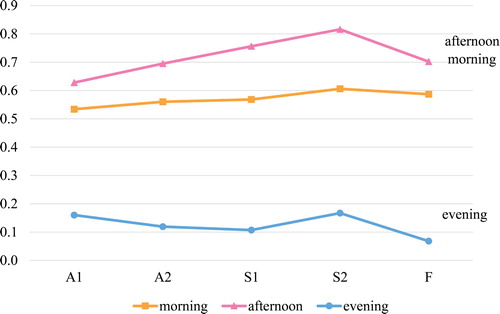
Figure A4. Estimated marginal means of cortisol in nmol/l (log10-transformed) for children with siblings.
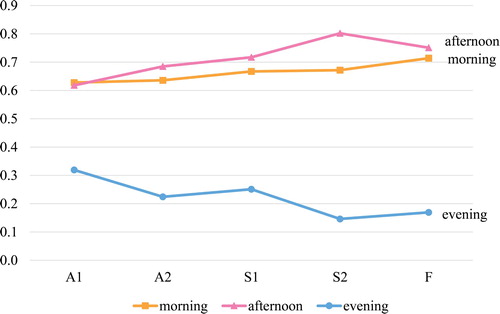
Figure A5. Estimated marginal means of cortisol in nmol/l (log10-transformed) for children in childcare groups with up to 11 children.
